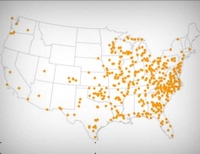Common Cause briefing on prison-based gerrymandering in Connecticut draws interest from legislators.
by Aleks Kajstura,
May 18, 2011
Connecticut’s Common Cause held a briefing at the capitol to discuss prison-based gerrymandering in Connecticut.
The CT News Junkie covered the briefing, including some more in-depth reporting:
Bilal Dabir Sekou, associate professor of political science at the University of Hartford, used some statistics to illustrate the effect gerrymandering has on minorities. Black and Latino residents make up just 19 percent of the state’s population but are 72 percent of the inmate population, he said.
According to data from the 2000 Census, 75 percent of state’s prison cells are located in districts that are disproportionately white, he said. Most of the prisons are in five towns: Cheshire, East Lyme, Enfield, Somers, and Suffield, he said. Together, those towns are technically home to just 1 percent of the state’s prisoners, he said.
“Fifteen percent of one district was incarcerated, giving every group of 85 residents near the prison as much political influence as 100 residents as any other district in the state,” he said.
…
Rep. Tim O’Brien, D-New Britain, said that prison-based gerrymandering is a distortion of representation at the Connecticut’s Capitol. He pointed to a disconnect in the state’s laws.
There is a law that requires inmates who are eligible and willing to vote, to do so by absentee ballot in the municipality they came from, he said. But when it comes to population counts for legislative districts they are counted where they are incarcerated, he said.
Jonathan Kantrowitz also blogs about the issue at the CT Post.
Video of the briefing at the capitol is available on Connecticut Network. The briefing includes Connecticut legislators and representatives from Common Cause, Prison Policy initiative, A Better Way Foundation and the NAACP’s Legal Defense Fund (LDF).
The Common Cause press release:
Common Cause in Connecticut Urges State to End Prison Based Gerrymandering
As Connecticut prepares for the once a decade legislative redistricting and reapportionment, Common Cause in Connecticut called on political leadership to end Prison Based Gerrymandering, the problem caused by the counting incarcerated people in Connecticut as residents of the correctional facility not their home addresses. During the last Census in 2000, the U.S counted almost 20,000 people in state or federal prison cells in the state. Without using prisoners as padding, 7 state house districts would not meet federal minimum population requirements and would need to be redrawn.
“Prison-based gerrymandering distorts the democratic process and dilutes minority voting rights,” said Dale Ho, Assistant Counsel at the NAACP Legal Defense Fund. “Towns that have large prison populations, like Enfield, have decided not to treat prisoners as members of the local community when drawing local election district lines. The state as a whole should follow their example, and should stop using prison populations to arbitrarily and irrationally inflate the voting power of a handful of districts to the detriment of all other Connecticut citizens.”
“When I was incarcerated, I was prohibited by law from claiming that town as my residence,” said Kenny Jackson, Family Reentry of Bridgeport, “I shouldn’t have been counted there as if I was a resident.”
Connecticut should follow the lead of Maryland, Delaware and New York and abolish prison based gerrymandering. All three states passed legislation requiring the state to collect home address for incarcerated persons. The home address data will be used to adjust Census data for redistricting purposes so that districts will be based on everyone’s actual place of residence.
Peter Wagner, Executive Director of the Prison Policy Initiative said “The lines being drawn now will be in place for the next decade. The General Assembly needs to act quickly to ensure that all residents – regardless of whether they live next to a prison – are given the same voice.”
The Prison Policy Initiative’s analysis of the districts drawn after the 2000 Census found that:
-
15% of one district was incarcerated, giving every group of 85 residents near the prison as much political influence as 100 residents in any other district in the state.
-
The majority of the state’s prison cells are in the 5 towns of Cheshire, East Lyme, Enfield, Somers and Suffield that together are home for just 1% of the state’s prisoners.
-
In a state where African-Americans are almost 13 times as likely to be incarcerated as whites, and Latinos are incarcerated 7.5 times as often as whites, crediting people in prison to the districts that contain the prisons has negative effects on minority representation. According to the Prison Policy Initiative, 75% of the state’s prison cells are in legislative districts that are disproportionately White.
Reapportionment and Redistricting signal that decisions will soon be made about how many Representatives each State gets and even who will be your next Representatives and how likely they are to stay in power. And this is all happening without your vote, “All communities suffer when a small portion of Connecticut residents are granted more than their fair share of representation while the rest of Connecticut voters effectively have their votes diluted,” Cheri Quickmire, Executive Director of Common Cause in Connecticut said, “Giving a few communities extra representation just because they happen to have a correctional facility is not fair to the rest of Connecticut’s citizens.”
###



